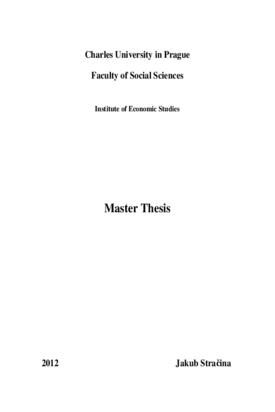Austrian Business Cycle Theory and the Recession of 2007-2009 in the US Economy
Rakúska teória hospodárskeho cyklu a recesia 2007-2009 v ekonomike USA
diploma thesis (DEFENDED)

View/
Permanent link
http://hdl.handle.net/20.500.11956/46969Identifiers
Study Information System: 108167
CU Caralogue: 990014307270106986
Collections
- Kvalifikační práce [18670]
Author
Advisor
Referee
Mejstřík, Michal
Faculty / Institute
Faculty of Social Sciences
Discipline
Economics
Department
Institute of Economic Studies
Date of defense
2. 2. 2012
Publisher
Univerzita Karlova, Fakulta sociálních vědLanguage
English
Grade
Excellent
Keywords (Czech)
business cycle theory, recession, US economyKeywords (English)
business cycle theory, recession, US economyCieľom tejto práce je zhodnotiť význam rakúskej teórie hospodárskeho cyklu pri vysvetlenie hospodárskeho cyklu rokov 2001-2009 v ekonomike USA. Teória postuluje schopnosť monetárneho šoku narušiť alokačné mechanizmy v ekonomike. V dôsledku toho dochádza k deformácii štruktúry relatívnych cien a tomu zodpovedajúcej misalokácii zdrojov. Ekonómia tak nasleduje neudržateľnú investičnú trajektóriu, ktorá je nekonzistentná s dostupnosťou zdrojov a preferenciami spotrebiteľov. Pri odhalení nekonzistencii sú niektoré investície likvidované a nasleduje nákladná korekcia. Práca podáva výklad teórie, stručný popis ekonomiky USA v období 2001-2009 a konfrontáciu teórie s datami. Napriek pripusteniu niektorých odchýlok, hlavne vo vývoji pracovného trhu, analýza prezentovaná v práci podporuje rakúsku teóriu hospodárskeho cyklu ako silný teoretický nástroj k vysvetleniu ekonomických udalostí skúmaného obdobia. Ako hlavnú silu teórie možno identifikovať jej schopnosť vysvetľovať vývoj relatívnych cien v súvislosti s podmienkami na trhu zápožičných fondov.
This paper aims to evaluate merits of the Austrian business cycle theory in explaining the 2001-2009 business cycle in the US economy. The theory postulates that a monetary shock upsets equilibrium in the market for loanable funds and adversely influences coordination mechanisms of the economy. The structure of relative prices is distorted and resources are misallocated as a result. The economy follows an unsustainable investment trajectory inconsistent with the amount of available resources and with the consumer preferences. When the inconsistencies are revealed, some of the investments are liquidated and costly correction follows. After providing exposition of the theory and description of the US economy in 2001-2009, the theory is confronted with the data. Although some deviations are conceded, mainly in development of the labor market, analysis presented in the paper supports the Austrian business cycle theory as a solid theoretical tool for explanation of the economic development throughout the examined period. The theory exhibits its main strengths in accounting for development of relative prices and linking them to conditions in the market for loanable funds.
